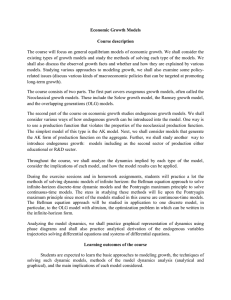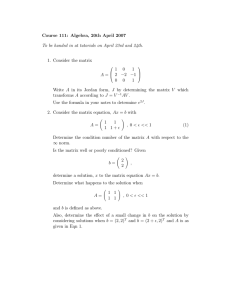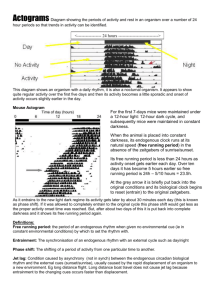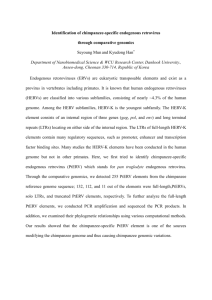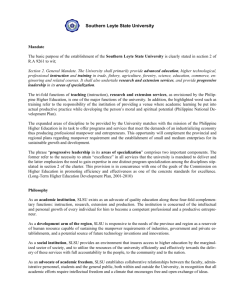RDEs and the veto-voter model Solutions to the transformed RDE Examples
advertisement
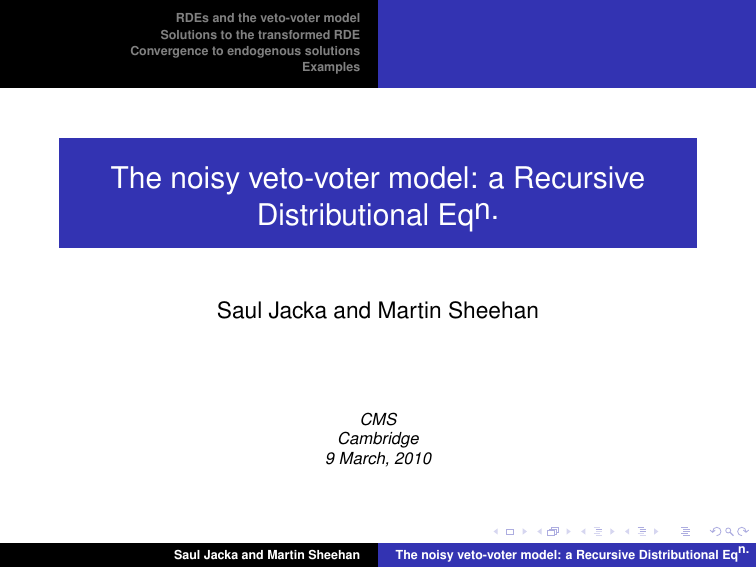
RDEs and the veto-voter model
Solutions to the transformed RDE
Convergence to endogenous solutions
Examples
The noisy veto-voter model: a Recursive
Distributional Eqn.
Saul Jacka and Martin Sheehan
CMS
Cambridge
9 March, 2010
Saul Jacka and Martin Sheehan
The noisy veto-voter model: a Recursive Distributional Eqn.
RDEs and the veto-voter model
Solutions to the transformed RDE
Convergence to endogenous solutions
Examples
The veto-voter equation
Background on RDEs
Transforming the problem
∙ Model: random number, M of independent voters each get a
veto on a decision: Yi = 0 or 1, where veto=0. Final result, Y ,
is recorded as a 1 or 0 with error probability 1 − p. Thus
Y =𝜉
M
∏
Yi + (1 − 𝜉)(1 −
i=1
M
∏
Yi ),
(1)
i=1
where 𝜉 is Ber(p) and the Yi s, M and 𝜉 are all independent.
∙ Alternative interpretation: model for a noisy distributed
error-reporting system. Here a 0 represents an error report
from a sub-system. Noise can reverse the binary (on-off) report
from any sub-system.
Saul Jacka and Martin Sheehan
The noisy veto-voter model: a Recursive Distributional Eqn.
RDEs and the veto-voter model
Solutions to the transformed RDE
Convergence to endogenous solutions
Examples
The veto-voter equation
Background on RDEs
Transforming the problem
Interest is centred on iterations of this structure.
In particular, we seek a stationary distribution, 𝜈, such that if Yi
are iid with distribution 𝜈 and are independent of (M, 𝜉), then Y
also has distribution 𝜈.
Saul Jacka and Martin Sheehan
The noisy veto-voter model: a Recursive Distributional Eqn.
RDEs and the veto-voter model
Solutions to the transformed RDE
Convergence to endogenous solutions
Examples
The veto-voter equation
Background on RDEs
Transforming the problem
So seek distributions 𝜈 on [0, 1] such that (Yi ; 1 ≤ i) are iid with
distribution 𝜈 ⇒ Y satisfying (1) also has distribution 𝜈.
More precisely, with 𝒫 = p.m.s on [0, 1], suppose that M has
distribution d on ℤ+ and define the map 𝒯 ≡ 𝒯d : 𝒫 → 𝒫 by
𝒯 (𝜈) = Law(𝜉
M
∏
Yi + (1 − 𝜉)(1 −
i=1
M
∏
Yi ))
i=1
when the Yi are iid ∼ 𝜈 and are independent of M, and seek
dynamics and fixed points of 𝒯 .
Saul Jacka and Martin Sheehan
The noisy veto-voter model: a Recursive Distributional Eqn.
RDEs and the veto-voter model
Solutions to the transformed RDE
Convergence to endogenous solutions
Examples
The veto-voter equation
Background on RDEs
Transforming the problem
The existence and uniqueness of fixed points of this type of
map, together with properties of the solutions, are addressed
by Aldous and Bandhapadhyay in [1]), though we are dealing
with a non-linear case to which the main results do not apply.
Saul Jacka and Martin Sheehan
The noisy veto-voter model: a Recursive Distributional Eqn.
RDEs and the veto-voter model
Solutions to the transformed RDE
Convergence to endogenous solutions
Examples
The veto-voter equation
Background on RDEs
Transforming the problem
Generalisation of setting is so-called tree-indexed problem or
Recursive Tree Process (RTP), in which we think of the Yi as
being marks associated with the daughter nodes of the root of
T , a family tree of a Galton-Watson branching process.
Start at level m of the random tree. Each vertex v in level m − 1
of the tree has Mv daughter vertices, where the Mv are i.i.d.
with common distribution d, and has associated with it noise 𝜉v ,
where the (𝜉u ; u ∈ T ) are iid and are independent of the
(Mu ; u ∈ T ).
By associating with daughter vertices independent random
variables Yvi having distribution 𝜈, we see that Yv and
Yvi ; 1 ≤ i ≤ Mv satisfy equation (1).
Saul Jacka and Martin Sheehan
The noisy veto-voter model: a Recursive Distributional Eqn.
RDEs and the veto-voter model
Solutions to the transformed RDE
Convergence to endogenous solutions
Examples
The veto-voter equation
Background on RDEs
Transforming the problem
In this setting get the notion of endogeny.
Loosely speaking, a solution to the tree-indexed problem is said
to be endogenous if it is a function of the noise alone so that no
additional randomness is present.
Saul Jacka and Martin Sheehan
The noisy veto-voter model: a Recursive Distributional Eqn.
RDEs and the veto-voter model
Solutions to the transformed RDE
Convergence to endogenous solutions
Examples
The veto-voter equation
Background on RDEs
Transforming the problem
∙ Work on a rooted tree with infinite branching factor. Random
tree is embedded within it. An initial ancestor (in level zero),
which we denote ∅, gives rise to a countably infinite number of
daughter vertices (which form the members of the first
generation), etc.
∙ Assign each vertex an address: members of the first
generation are denoted 1, 2, ..., the second generation by
11, 12, . . . 21, 22, . . . , 31, 32, . . . etc.
∙ Write uj, j = 1, 2, ... for daughters of a vertex u.
Saul Jacka and Martin Sheehan
The noisy veto-voter model: a Recursive Distributional Eqn.
RDEs and the veto-voter model
Solutions to the transformed RDE
Convergence to endogenous solutions
Examples
The veto-voter equation
Background on RDEs
Transforming the problem
∙ Write
∪ T forn the collection of all vertices or nodes (i.e.
T= ∞
n=0 ℕ ) partitioned by depth.
∙ Define the depth function ∣ ⋅ ∣ by ∣u∣ = n if vertex u is in level n
of tree. Associate to each vertex u iid random variables Mu with
distribution d, giving the number of offspring produced by u.
The vertices u1, u2, ..., uMu are thought of as being alive
(relative to u) and the {uj : j > Mu } as dead.
∙ Write original equation as a recursion on the vertices of T:
Yu = 𝜉u
Mu
∏
Yui + (1 − 𝜉u )(1 −
i=1
Saul Jacka and Martin Sheehan
Mu
∏
Yui ), u ∈ T.
(2)
i=1
The noisy veto-voter model: a Recursive Distributional Eqn.
RDEs and the veto-voter model
Solutions to the transformed RDE
Convergence to endogenous solutions
Examples
The veto-voter equation
Background on RDEs
Transforming the problem
Advantage of the embedding now becomes clear: we can talk
about the RDE at any vertex in the infinite tree and yet,
because the product only runs over the live daughters relative
to u, the random Galton-Watson family tree is encoded into the
RDE as noise.
Saul Jacka and Martin Sheehan
The noisy veto-voter model: a Recursive Distributional Eqn.
RDEs and the veto-voter model
Solutions to the transformed RDE
Convergence to endogenous solutions
Examples
The veto-voter equation
Background on RDEs
Transforming the problem
Live descendants of root node to depth 3
Y∅
Y1
Y3
Y2
Y31
Y12
Y21
Y111 Y112
Y121
Y211 Y221 Y222 Y223 Y231 Y311 Y312
Saul Jacka and Martin Sheehan
Y22
Y23
Y11
Y32
Y321
The noisy veto-voter model: a Recursive Distributional Eqn.
RDEs and the veto-voter model
Solutions to the transformed RDE
Convergence to endogenous solutions
Examples
The veto-voter equation
Background on RDEs
Transforming the problem
Easy to transform the RDE (2) into the following, simpler, RDE:
Xu = 1 −
Nu
∏
Xui , u ∈ T.
(3)
i=1
∙ Colour red all the nodes, v , for which 𝜉v = 0.
∙ Proceed down each line of descent from a node u until we hit
a red node.
∙ In this way, we either "cut" the tree at collection of nodes
which we regard as revised family of u, or not, in which case u
has an infinite family.
Saul Jacka and Martin Sheehan
The noisy veto-voter model: a Recursive Distributional Eqn.
RDEs and the veto-voter model
Solutions to the transformed RDE
Convergence to endogenous solutions
Examples
The veto-voter equation
Background on RDEs
Transforming the problem
∙ Denote new random family size by Nu then
Yu = 1 −
Nu
∏
Yûi ,
i=1
if u is red, where ûi denotes the ith red node in the revised
family of u.
∙ Condition on node u being red, then with this revised tree we
obtain the RDE (3).
∙ Family size in new tree corresponds to total number of deaths
in the original tree when it is independently thinned, with the
descendants pruned with probability q.
Saul Jacka and Martin Sheehan
The noisy veto-voter model: a Recursive Distributional Eqn.
RDEs and the veto-voter model
Solutions to the transformed RDE
Convergence to endogenous solutions
Examples
The veto-voter equation
Background on RDEs
Transforming the problem
∙ PGF, H, of the family size Nu on the new tree H is minimal
positive solution of
H(z) = G(pH(z) + qz),
(4)
where original tree has family size PGF G.
Saul Jacka and Martin Sheehan
The noisy veto-voter model: a Recursive Distributional Eqn.
RDEs and the veto-voter model
Solutions to the transformed RDE
Convergence to endogenous solutions
Examples
The veto-voter equation
Background on RDEs
Transforming the problem
Live descendants of root node to depth 3
Y∅
Y1
Y3
Y2
Y31
Y12
Y21
Y111 Y112
Y121
Y211 Y221 Y222 Y223 Y231 Y311 Y312
Saul Jacka and Martin Sheehan
Y22
Y23
Y11
Y32
Y321
The noisy veto-voter model: a Recursive Distributional Eqn.
RDEs and the veto-voter model
Solutions to the transformed RDE
Convergence to endogenous solutions
Examples
The veto-voter equation
Background on RDEs
Transforming the problem
Tree with red nodes to depth 3
Y∅
Y1
Y3
Y2
Y31
Y12
Y21
Y111 Y112
Y121
Y211 Y221 Y222 Y223 Y231 Y311 Y312
Saul Jacka and Martin Sheehan
Y22
Y23
Y11
Y32
Y321
The noisy veto-voter model: a Recursive Distributional Eqn.
RDEs and the veto-voter model
Solutions to the transformed RDE
Convergence to endogenous solutions
Examples
The veto-voter equation
Background on RDEs
Transforming the problem
Tree with red nodes to depth 3
X∅
X7
X3
X1
X2
X5
X4
Saul Jacka and Martin Sheehan
X73
X6
X71 X72
n.
The noisy veto-voter model: a Recursive Distributional Eq
RDEs and the veto-voter model
Solutions to the transformed RDE
Convergence to endogenous solutions
Examples
The veto-voter equation
Background on RDEs
Transforming the problem
X∅
X1
X2
X3
Pruned tree
Saul Jacka and Martin Sheehan
X4
X5
X6
X7
X71
X72
X73
The noisy veto-voter model: a Recursive Distributional Eqn.
RDEs and the veto-voter model
Solutions to the transformed RDE
Convergence to endogenous solutions
Examples
The moment equation
Preliminary analysis
The endogenous solution
Proofs
Examples
From now on, assume that
ℙ(2 ≤ N < ∞) > 0 which ⇔ H is strictly convex,
and we will consider non-negative solutions to (3) (easy to see
these must lie in [0, 1])
Rewrite (3) as
1−X =
N
∏
Xi .
i=1
Then
(1 − X )n =
N
∏
Xin ⇒ E[(1 − X )n ] = E[
i=1
Saul Jacka and Martin Sheehan
N
∏
Xin ] = H(E[X n ]).
i=1
The noisy veto-voter model: a Recursive Distributional Eqn.
RDEs and the veto-voter model
Solutions to the transformed RDE
Convergence to endogenous solutions
Examples
The moment equation
Preliminary analysis
The endogenous solution
Proofs
Examples
Denote the nth moment of a generic solution to (3) by mn , then
H(mn ) =
n ( )
∑
n
k =0
or
H(mn ) + (−1)
n−1
k
(−1)k mk
n−1 ( )
∑
n
mn =
(−1)k mk .
k
(5)
k =0
Saul Jacka and Martin Sheehan
The noisy veto-voter model: a Recursive Distributional Eqn.
RDEs and the veto-voter model
Solutions to the transformed RDE
Convergence to endogenous solutions
Examples
The moment equation
Preliminary analysis
The endogenous solution
Proofs
Examples
Define
𝜙 : t 7→ H(t) + t and 𝜓 : t 7→ H(t) − t.
Clearly moment equation ⇒ m1 solves 𝜙(t) = 1.
∙ Since 𝜙(0) < 1 < 1 + 𝜙(1) and H is cts and strictly increasing,
there is a unique solution 𝜇1 and so unique solution to RDE on
{0, 1} is Ber(𝜇1 ).
∙ Result from [1] guarantees tree-indexed solution
corresponding to a solution to the basic RDE and we denote
such a solution by S.
Saul Jacka and Martin Sheehan
The noisy veto-voter model: a Recursive Distributional Eqn.
RDEs and the veto-voter model
Solutions to the transformed RDE
Convergence to endogenous solutions
Examples
∙
∙
∙
∙
The moment equation
Preliminary analysis
The endogenous solution
Proofs
Examples
Q: Are there other solutions?
A: Sometimes!
Q: Is this solution endogenous?
A: Sometimes!
Saul Jacka and Martin Sheehan
The noisy veto-voter model: a Recursive Distributional Eqn.
RDEs and the veto-voter model
Solutions to the transformed RDE
Convergence to endogenous solutions
Examples
The moment equation
Preliminary analysis
The endogenous solution
Proofs
Examples
∙ Consider possible values for second moment, m2 .
∙ From moment equation, must solve
𝜓(t) = 1 − 2𝜇1 .
∙ Clearly 𝜇1 is a solution (S has all moments equal to 𝜇1 ).
Moreover 𝜓 inherits strict convexity from H so at most two
solutions.
∙ There is an acceptable candidate (i.e. a soln. less than 𝜇1 ) iff
𝜇1 > 𝜇∗ , the argmin of 𝜓, and this clearly happens iff
H ′ (𝜇1 ) > 1. Iterating argument, see there are two candidate
moment sequences iff H ′ (𝜇1 ) > 1.
Saul Jacka and Martin Sheehan
The noisy veto-voter model: a Recursive Distributional Eqn.
RDEs and the veto-voter model
Solutions to the transformed RDE
Convergence to endogenous solutions
Examples
The moment equation
Preliminary analysis
The endogenous solution
Proofs
Examples
∙ Still can’t guarantee two different solutions in this case but
since we’re working on a bounded domain, moment sequences
are distribution-determining so only a singular solution in case
where H ′ (𝜇1 ) ≤ 1.
Saul Jacka and Martin Sheehan
The noisy veto-voter model: a Recursive Distributional Eqn.
RDEs and the veto-voter model
Solutions to the transformed RDE
Convergence to endogenous solutions
Examples
The moment equation
Preliminary analysis
The endogenous solution
Proofs
Examples
∙ Suppose we take conditional expectations in RDE (conditional
on all noise in the tree). We get
∏ u
Cu = E[Su ∣𝜎(Nv : v ∈ T)] = E[1 − N
i=1 Sui ∣𝜎(Nv : v ∈ T)]
∏Nu
= 1 − i=1 E[Sui ∣𝜎(Nv : v ∈ T)]
∏ u
=1− N
i=1 Cui ,
i.e. C also solves the RDE! This is not as special as it looks.
∙ Follows that, when H ′ (𝜇1 ≤ 1), C = S and this is unique
solution and endogenous.
Saul Jacka and Martin Sheehan
The noisy veto-voter model: a Recursive Distributional Eqn.
RDEs and the veto-voter model
Solutions to the transformed RDE
Convergence to endogenous solutions
Examples
The moment equation
Preliminary analysis
The endogenous solution
Proofs
Examples
∙ Q: What about the case where H ′ (𝜇1 ) > 1?
∙ A: It turns out that in this case C and S are distinct and
give the only solutions!
The proof is tortuous but works like this:
1 Use a martingale argument to show that C is the unique
endogenous solution
2 Use a result of Warren to show that in case where N is
bounded, S is endogenous iff H ′ (𝜇1 ) ≤ 1.
3 Take limits and conclude that when H ′ (𝜇1 ) > 1, S ∕= C and
deduce there are exactly two solutions in this case.
Saul Jacka and Martin Sheehan
The noisy veto-voter model: a Recursive Distributional Eqn.
RDEs and the veto-voter model
Solutions to the transformed RDE
Convergence to endogenous solutions
Examples
The moment equation
Preliminary analysis
The endogenous solution
Proofs
Examples
Sketch proof of 1: Fix an endogenous solution X and define for
[n]
each vertex u: Cu = E[Xu ∣(Nv : ∣v ∣ ≤ n + ∣u∣)]. Clearly C is a
bounded martingale so converges a.s. and in L2 to Xu (since X
is endogenous). But
[n]
Cu
= E[1 −
Nu
∏
Xui1 ∣(Nv : ∣v ∣ ≤ n + ∣u∣)]
i1 =1
= 1−
Nu
∏
[n−1]
Cui1
i1 =1
= 1−
Nu
∏
i1 =1
⎛
Nui1
⎝1 −
∏(
Nui1 i2 ...in−1
...(1 −
i2 =1
∏
⎞
Nui1 i2 ...in
(1 − 𝜇1
)
))... ⎠
in =1
and this is clearly independent of the choice of X .
Saul Jacka and Martin Sheehan
The noisy veto-voter model: a Recursive Distributional Eqn.
RDEs and the veto-voter model
Solutions to the transformed RDE
Convergence to endogenous solutions
Examples
The moment equation
Preliminary analysis
The endogenous solution
Proofs
Examples
Sketch proof of 2:
∙ Warren’s result is for solutions to symmetric RDEs on a rooted
d-ary tree:
Yu = h(Yu1 , . . . , Yud ; 𝜉u ),
(6)
where the Y s live on a finite space 𝒮 with law 𝜋 and 𝜉 has law 𝜈.
∙ Now look at a single line of descent, e.g. Y∅ , Y1 , Y11 . . . and
rename as Y0 , Y−1 , . . . . This is clearly a Markov chain and (6)
gives us an innovations description. Now couple two copies, Y
and Y ′ by using the same innovations to generate both, to get a
MC on 𝒮 2 .
Saul Jacka and Martin Sheehan
The noisy veto-voter model: a Recursive Distributional Eqn.
RDEs and the veto-voter model
Solutions to the transformed RDE
Convergence to endogenous solutions
Examples
The moment equation
Preliminary analysis
The endogenous solution
Proofs
Examples
Line of descent (d = 3)
Y∅
Y1
Y11
Y12
Y2
Y3
Y13
Y111 Y112 Y113
Saul Jacka and Martin Sheehan
The noisy veto-voter model: a Recursive Distributional Eqn.
RDEs and the veto-voter model
Solutions to the transformed RDE
Convergence to endogenous solutions
Examples
The moment equation
Preliminary analysis
The endogenous solution
Proofs
Examples
Now kill this MC on coupling and denote the reduced matrix by
P − . The coupling time has a decay rate of 𝜌 where 𝜌 is the
Perron- Frobenius eigenvalue of ℙ− . Warren’s result is:
Y is endogenous iff either
▶
Case 1: d𝜌 < 1
or
▶
Case 2: d𝜌 = 1 and ℙ− is irreducible and
L2 (Y∅ ) ∩ L2 (𝜉u : u ∈ 𝒯 )⊥ = {0}.
Note: this is a nice improvement on a key result in [1], which
looks at 𝒯 (2) , corresponding to coupling all lines of descent
simultaneously.
Saul Jacka and Martin Sheehan
The noisy veto-voter model: a Recursive Distributional Eqn.
RDEs and the veto-voter model
Solutions to the transformed RDE
Convergence to endogenous solutions
Examples
The moment equation
Preliminary analysis
The endogenous solution
Proofs
Examples
∙ Apply this to our problem by imposing upper bound of n to
branching factor/family size.
−
∙ Quick calculation then shows that P(1,0),(1,0)
= 0 and
−
] = H ′ (𝜇1 )/n. So this is also 𝜌.
P(1,0),(0,1)
= E[ Nn 𝜇N−1
1
∙ Quick check shows that conditions are satisfied in case 2, so
S is endogenous in case of bounded branching factor, iff
(n)
H ′ (𝜇1 ) ≤ 1, where n refers to imposed upper bound on
random branching factor.
Saul Jacka and Martin Sheehan
The noisy veto-voter model: a Recursive Distributional Eqn.
The moment equation
Preliminary analysis
The endogenous solution
Proofs
Examples
RDEs and the veto-voter model
Solutions to the transformed RDE
Convergence to endogenous solutions
Examples
Sketch proof of 3.
(n)
(n)
∙ Hn ↓ H so 𝜇1 ↑ 𝜇1 and Hn′ (𝜇1 ) → H ′ (𝜇1 ), so if H ′ (𝜇1 ) > 1
(n)
then Hn′ (𝜇1 ) > 1 for large n.
(n) L2
∙ Similarly, Cu → Cu , but for large n C (n) ∕= S (n) (because
(n)
(n)
Hn′ (𝜇1 ) > 1) so 𝜇2 → 𝜇2 < 𝜇∗ and hence 𝜇2 ∕= 𝜇1 .
∙ Thus we have:
singular solution is endogeneous iff H ′ (𝜇1 ) ≤ 1
Saul Jacka and Martin Sheehan
The noisy veto-voter model: a Recursive Distributional Eqn.
RDEs and the veto-voter model
Solutions to the transformed RDE
Convergence to endogenous solutions
Examples
The moment equation
Preliminary analysis
The endogenous solution
Proofs
Examples
Example
N has generating function H(x) = x 2 (i.e. N ≡ 2). Then
moment equation tells us that
m12 + m1 − 1 = 0
√
so that m1 = ( 5 − 1)/2. For m2 we have
√
m22 − m2 − (2 − 5) = 0
so that m2 = m1 or m12 and so on. In fact the two possible
√
moment sequences turn√out to be m0 = 1, mn = ( 5 − 1)/2 for
n ≥ 1 or m0 = 1, m1 = ( 5 − 1)/2, mn = m1n for n ≥ 2. they
correspond to the singular solution and the endogenous one
(the latter is constant! This is expected because there is no
noise in the tree.)
Saul Jacka and Martin Sheehan
The noisy veto-voter model: a Recursive Distributional Eqn.
RDEs and the veto-voter model
Solutions to the transformed RDE
Convergence to endogenous solutions
Examples
The moment equation
Preliminary analysis
The endogenous solution
Proofs
Examples
Example
𝛼s
(with 𝛽 = 1 − 𝛼).
N ∼Geometric(𝛼) so H(s) = 1−𝛽s
√
It follows that 𝜇1 = 1 − 𝛼 and then H ′ (𝜇1 ) = 1, so unique
endogenous solution to the original RDE is discrete and value
at root is a.s. limit of
1−
N∅
∏
N
(1 −
i1 =1
i1
∏
(. . . (1 − (1 −
√
𝛼)Ni1 ,...,in ) . . .)).
i2 =1
Saul Jacka and Martin Sheehan
The noisy veto-voter model: a Recursive Distributional Eqn.
RDEs and the veto-voter model
Solutions to the transformed RDE
Convergence to endogenous solutions
Examples
The basin of attraction
Outside the basin of attraction
Let 𝜁 be law of endogenous solution. For any initial distribution
𝜈, get 𝒯 n (𝜈) by inserting iid random variables with law 𝜈 at level
n of the tree and applying the recursion to obtain the
corresponding solution Xun (𝜈) (with law 𝒯 n−∣u∣ (𝜈)) at vertex u.
The basin of attraction B(𝜋) of any solution is given by
B(𝜋) = {𝜈 ∈ ℙ : 𝒯 n (𝜈)
weak∗
→ 𝜋},
which is, of course, equivalent to the set of distributions 𝜈 for
which Xun (𝜈) converges in law to a solution X of the RDE, with
law 𝜋.
Saul Jacka and Martin Sheehan
The noisy veto-voter model: a Recursive Distributional Eqn.
RDEs and the veto-voter model
Solutions to the transformed RDE
Convergence to endogenous solutions
Examples
The basin of attraction
Outside the basin of attraction
Theorem
Let 𝛿 denote the discrete distribution on {0, 1} with mean 𝜇1 .
Then
∫
B(𝜁) = {𝜈 ∈ ℙ : xd𝜈(x) = 𝜇1 and 𝜈 ∕= 𝛿}.
That is, B(𝜁) is precisely the set of distributions on [0, 1] with the
correct mean (except the discrete distribution with mean 𝜇1 ).
Saul Jacka and Martin Sheehan
The noisy veto-voter model: a Recursive Distributional Eqn.
RDEs and the veto-voter model
Solutions to the transformed RDE
Convergence to endogenous solutions
Examples
The basin of attraction
Outside the basin of attraction
Theorem
In the stable case where H ′ (𝜇1 ) ≤ 1, let b(𝜇1 ) be the basin of
attraction of 𝜇1 under the iterative map for the first moment,
f : t 7→ 1 − H(t). Then
∫
B(𝜁) = {𝜈 ∈ ℙ : xd𝜈(x) ∈ b(𝜇1 )}.
∙ Both theorems are proved by analysis of 2nd moments to
show L2 convergence.
Saul Jacka and Martin Sheehan
The noisy veto-voter model: a Recursive Distributional Eqn.
RDEs and the veto-voter model
Solutions to the transformed RDE
Convergence to endogenous solutions
Examples
The basin of attraction
Outside the basin of attraction
∙ Q: What happens outside these basins of
attraction?
∙ A: get convergence to limit cycles of length
2!
Saul Jacka and Martin Sheehan
The noisy veto-voter model: a Recursive Distributional Eqn.
RDEs and the veto-voter model
Solutions to the transformed RDE
Convergence to endogenous solutions
Examples
The basin of attraction
Outside the basin of attraction
∙ It is easily seen that the map for the first moment
f : t 7→ 1 − H(t) can have only one- and two-cycles.
∙ This is because the iterated map f (2) : t 7→ 1 − H(1 − H(t)) is
increasing in t and hence can have only one-cycles. Notice
also that the fixed points (or one-cycles) of f (2) come in pairs: if
p is a fixed point then so too is 1 − H(p) = f (p).
Saul Jacka and Martin Sheehan
The noisy veto-voter model: a Recursive Distributional Eqn.
RDEs and the veto-voter model
Solutions to the transformed RDE
Convergence to endogenous solutions
Examples
The basin of attraction
Outside the basin of attraction
We consider the iterated RDE:
N∅
Ni
∏
∏
X = 1 − (1 −
Xij ).
i=1
(7)
j=1
This corresponds to the iterated map on laws on [0,1], 𝒯 2 .
−
Denote a generic two-cycle of the map f by the pair (𝜇+
1 , 𝜇1 ).
Saul Jacka and Martin Sheehan
The noisy veto-voter model: a Recursive Distributional Eqn.
RDEs and the veto-voter model
Solutions to the transformed RDE
Convergence to endogenous solutions
Examples
The basin of attraction
Outside the basin of attraction
Theorem
−
Suppose that (𝜇+
1 , 𝜇1 ) is a two-cycle of f . There are at most
two solutions of the RDE (7) with mean 𝜇1+ . There is a unique
endogenous solution C + , and a (possibly distinct) discrete
solution, S + , taking values in {0, 1}. The endogenous solution
C + is given by P(S + = 1∣T) (just as in the non-iterated case).
The solutions are distinct if and only if H ′ (𝜇1− )H ′ (𝜇1+ ) > 1, i.e. if
and only if 𝜇1+ (or 𝜇1− ) is an unstable fixed point of f (2) .
∙ Proof is again derived by looking at second moments and
proving L2 convergence.
Saul Jacka and Martin Sheehan
The noisy veto-voter model: a Recursive Distributional Eqn.
RDEs and the veto-voter model
Solutions to the transformed RDE
Convergence to endogenous solutions
Examples
Example
𝛼s
Recall: if N is Geometric(𝛼), H(s) = 1−𝛽s
(with 𝛽 = 1 − 𝛼). It
follows that
f (2) (s) = s,
1−s
so that every pair (s, 1−𝛽s
) is a two-cycle of f and the unique
√
fixed point of f is 1 − 𝛼. Follows that s is a neutrally stable
fixed point of f (2) for each s ∈ [0, 1].
For any s, there is a unique solution to the iterated RDE with
mean s and it is discrete and endogenous and is the a.s. limit
∏N∅
∏Ni1
N
of 1 − i1 =1
(1 − i2 =1
(. . . (1 − s i1 ,...,i2n−1 ) . . .)).
Saul Jacka and Martin Sheehan
The noisy veto-voter model: a Recursive Distributional Eqn.
RDEs and the veto-voter model
Solutions to the transformed RDE
Convergence to endogenous solutions
Examples
Example
Consider original noisy veto-voter model on binary tree. It
follows from (4) that
√
1 − 2pqz − 1 − 4pqz 2
2
.
H(z) = (pH(z) + qz) ⇒ H(z) =
2p2
This is non-defective if and only if p ≤ 12 (naturally), i.e. if and
only if extinction is certain in the trimmed tree from the original
veto-voter model. It is fairly straightforward to show that
H ′ (𝜇1 ) > 1 ⇔ p < 12 . Thus, the endogenous solution is
non-discrete precisely when the trimmed tree is sub-critical i.e.
when modified family size is a.s. finite.
Saul Jacka and Martin Sheehan
The noisy veto-voter model: a Recursive Distributional Eqn.
RDEs and the veto-voter model
Solutions to the transformed RDE
Convergence to endogenous solutions
Examples
Example
In contrast to the case of the veto-voter model on the binary
tree, the veto-voter model on a trinary tree can show a
non-endogenous discrete solution even when the trimmed tree
is supercritical. More precisely, the trimmed tree is supercritical
precisely when p > 13 , but the discrete solution is
√
(3) def 3. 3−4
= 3.√3−2 ,
non-endogenous if and only if p < pe
Saul Jacka and Martin Sheehan
(3)
and pe > 13 .
The noisy veto-voter model: a Recursive Distributional Eqn.
RDEs and the veto-voter model
Solutions to the transformed RDE
Convergence to endogenous solutions
Examples
Saul Jacka and Martin Sheehan
The noisy veto-voter model: a Recursive Distributional Eqn.
RDEs and the veto-voter model
Solutions to the transformed RDE
Convergence to endogenous solutions
Examples
D. Aldous and A. Bandyopadhyay (2005): A survey of max-type recursive distributional equations, Ann. Appl.
Probab., 15, 2, 1047 - 1110.
A. Bandyopadhyay (2006): A necessary and sufficient condition for the tail-triviality of a recursive tree
process, Sankhya, 68, 1, 1–23.
L. Rüschendorf (2006): On stochastic recursive equations of sum and max type, J. Appl. Prob., 43, 687 - 703.
J. Warren (2006): Dynamics and endogeny for processes indexed by trees, Stochastics, 78, 5, 327–342.
Saul Jacka and Martin Sheehan
The noisy veto-voter model: a Recursive Distributional Eqn.
RDEs and the veto-voter model
Solutions to the transformed RDE
Convergence to endogenous solutions
Examples
Theorem
(Aldous and Bandyopadhyay) Suppose 𝒮 is a Polish space.
Consider an invariant RTP with marginal distribution 𝜇.
Denoting by 𝜇↗ the diagonal measure on 𝒮 2 with marginals 𝜇
then we have:
(a) If the endogenous property holds, then 𝜇↗ is the unique
fixed point of 𝒯 (2) .
(b) Conversely, suppose 𝜇↗ is the unique fixed point of 𝒯 (2) . If
also 𝒯 (2) is continuous with respect to weak convergence on
the set of bivariate distributions with marginals 𝜇, then the
endogenous property holds.
(c) Further, the endogenous property holds if and only if
n
weak∗
𝒯 (2) (𝜇 ⊗ 𝜇) → 𝜇↗ .
Saul Jacka and Martin Sheehan
The noisy veto-voter model: a Recursive Distributional Eqn.


